Running shoes aren’t just a style choice — they’re a vital part of your comfort, performance, and injury prevention. Whether you’re pounding the pavement, covering miles on long hospital shifts, or walking through daily errands, knowing how long running shoes last is essential.
Wearing worn-out shoes can lead to foot pain, knee strain, or even long-term injuries that affect your overall mobility.
In this guide, we’ll cover:
- Average shoe lifespan by mileage and time.
- Key signs that your running shoes need replacing.
- Factors affecting durability, from materials to usage habits.
- Practical tips to extend the life of your favorite pairs.
By understanding these factors, you’ll be able to make smarter choices, get the most out of your shoes, and know exactly when it’s time to retire them.
How Long Do Running Shoes Last? The Considerable Factors
1. Average Lifespan of Running Shoes
Running shoes are built to provide comfort, cushioning, and support, but like any equipment, they have a limited lifespan. On average, most running shoes last 300–500 miles or about 4–6 months of regular use.
However, this can vary widely depending on individual factors, shoe type, and usage conditions. Understanding these variables helps you know when it’s time to replace your shoes to prevent discomfort or injury.
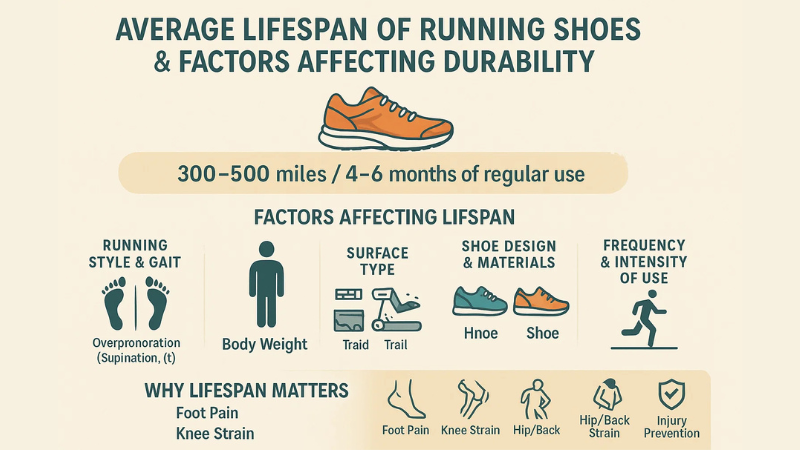
Factors Affecting Shoe Lifespan
- Running Style and Gait
Your foot mechanics play a huge role in shoe wear.
- Overpronation: Feet roll inward excessively, putting extra stress on the inner midsole
- Supination: Feet roll outward, wearing down the outer edges faster.
- Stride and Impact: Heavy-footed runners or walkers compress cushioning more quickly, reducing shock absorption.
- Body Weight:
Heavier individuals naturally exert more force on shoes with each step. This added pressure accelerates midsole compression and sole wear, potentially shortening shoe lifespan by months.
- Surface Type
- Hard surfaces like concrete, asphalt, or polished hospital floors wear down the outsole and midsole faster.
- Softer surfaces like treadmills, tracks, or trails are gentler, prolonging the shoe’s cushioning and overall durability.
- Shoe Design & Materials
- High-end shoes: Premium cushioning systems, durable outsoles, and reinforced uppers may last longer, but even these eventually compress or lose traction.
- Budget or minimalist shoes: May wear out faster due to lighter materials and thinner midsoles.
- Specialized shoes: Trail shoes or motion-control shoes may have extra durability in certain areas, but uneven wear can still occur based on usage.
- Frequency & Intensity of Use
Daily, high-mileage runners or workers on their feet for 8–12 hours (like nurses) will naturally wear shoes out faster than casual walkers. Shoes used for multiple activities like running, gym workouts, and casual wear may experience accelerated midsole breakdown.
Why Lifespan Matters
- Wearing shoes past their prime can lead to:
- Foot pain, plantar fasciitis, or heel discomfort.
- Knee, hip, or lower back strain from reduced shock absorption.
- Reduced performance during runs, workouts, or long shifts.
By tracking mileage, monitoring wear patterns, and understanding how your shoes respond to your gait and environment, you can replace shoes before they compromise comfort or safety, ensuring optimal performance and injury prevention.
2. How Many Miles Do Running Shoes Last
Running shoes are designed to protect your feet, provide cushioning, and support your stride. Over time, the materials in your shoes—especially the midsole foam and outsole—break down, reducing comfort, shock absorption, and overall performance.
One of the most accurate ways to know when your shoes need replacing is by tracking mileage, but this can vary widely depending on your usage.
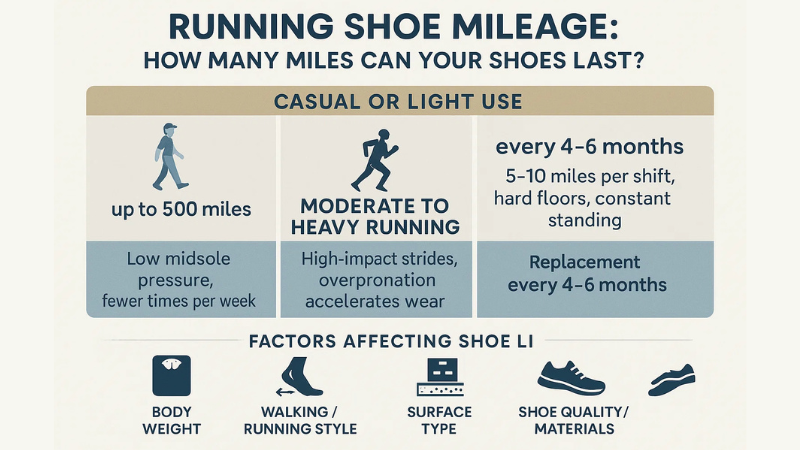
Mileage Estimates by Usage Type
Casual or Light Use-
Mileage: Up to 500 miles
Casual walkers or occasional joggers usually wear their shoes for short distances, a few times per week. Because pressure on the midsole is lower and usage is less frequent, cushioning lasts longer. Even so, shoes stored in damp or humid environments can age faster than expected.
Moderate to Heavy Running-
Mileage: Approximately 300–400 miles
Regular runners or athletes put consistent stress on shoes through repeated impact. Overpronation, high-impact strides, or running on hard surfaces like asphalt accelerate midsole compression. Worn shoes may cause shin splints, knee pain, or plantar fasciitis if replaced too late.
Healthcare Workers, Nurses, and Long-Hour Professionals-
Nurses and hospital staff can walk 5–10 miles or more per shift, depending on patient loads and hospital size. Hard floors, constant standing, and carrying or pushing equipment can cause shoes to wear faster than casual runners’ shoes. Even if the shoe isn’t used for “running,” the repetitive impact and pressure mimic high-mileage activity.
Factors Affecting Shoe Longevity
- Body Weight:
Heavier individuals compress cushioning faster.
- Running or Walking Style:
Heel strikers or overpronators wear out midsoles sooner.
- Surface Type:
Concrete, tile, or polished floors cause more abrasion than tracks or treadmills.
- Shoe Quality and Materials:
Premium foam, reinforced outsoles, and durable uppers last longer, but all shoes eventually lose their structural support.
Why Monitoring Mileage Matters
- Prevents Pain and Injury:
Worn shoes can contribute to foot, knee, hip, and back issues.
- Maintains Comfort:
Cushioned shoes reduce fatigue during long walks, shifts, or workouts.
- Preserves Performance:
Shoes that lose flexibility or support can affect stride efficiency and stability.
- Safety on Hard Surfaces:
Degraded soles or worn traction increase the risk of slips, especially for nurses and healthcare staff on polished floors.
By understanding how many miles your shoes can handle and tracking your daily or weekly usage, you can plan timely replacements, ensuring optimal comfort, protection, and performance. Whether you’re running a marathon or walking hospital corridors, keeping an eye on shoe mileage is key to healthy, happy feet.
3. Signs Your Running Shoes Need Replacing
Even if your running shoes still look decent on the outside, internal wear can compromise comfort, support, and safety. Recognizing the warning signs early helps prevent injuries, discomfort, and long-term joint issues.
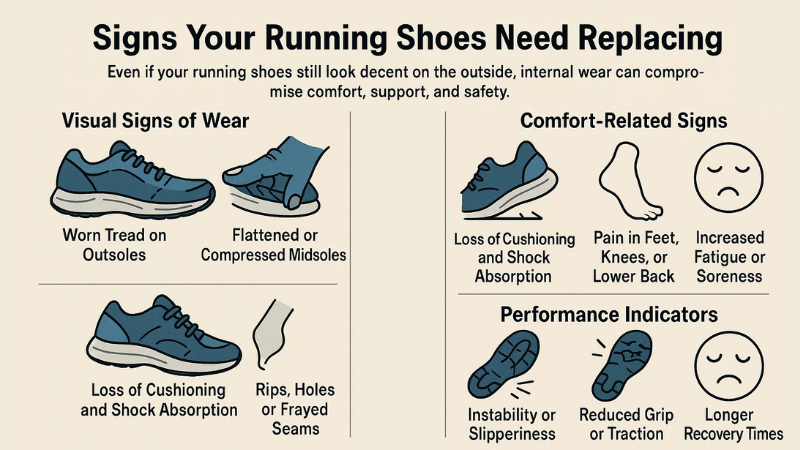
1. Visual Signs of Wear
- Worn Tread on Outsoles:
The rubber on the bottom of your shoes may be smooth or unevenly worn. Check high-impact areas like the heel and ball of the foot.
- Flattened or Compressed Midsoles:
Over time, the foam loses its springiness, reducing shock absorption. Press your fingers into the midsole—if it feels hard or unresponsive, it’s time to replace.
- Rips, Holes, or Frayed Seams:
Any visible damage to the upper, stitching, or lining can reduce support and durability, especially in high-stress areas like the toe box or heel counter.
2. Comfort-Related Signs
- Loss of Cushioning and Shock Absorption:
If your shoes feel “flat” or you notice more impact when walking, running, or standing, the midsoles have likely broken down.
- Pain in Feet, Knees, or Lower Back:
Old shoes can misalign your gait, leading to discomfort in your arches, heels, shins, knees, hips, or back. Such shoes can cause severe toe pain if you wear them for a long time. This can cause serious health issues in the long run.
- Increased Fatigue or Soreness:
If daily activities, long walks, or hospital shifts leave your feet more tired than usual, it’s often due to reduced support.
3. Performance Indicators
- Instability or Slipperiness:
Shoes that wobble, roll inward, or slide on smooth surfaces can increase the risk of falls or ankle injuries.
- Reduced Grip or Traction:
Outsoles worn down from repeated use may slip on wet or polished floors—important for runners on trails or nurses on hospital corridors.
- Longer Recovery Times:
Experiencing delayed soreness or longer recovery periods after walking, running, or standing indicates diminished shock absorption.
Key Takeaway
Replacing running shoes at the right time maintains foot health, prevents pain, and ensures proper gait and posture. For nurses, long-shift workers, or runners, monitoring these signs is just as important as tracking mileage. Shoes that look fine on the outside may be silently losing their ability to protect your feet and joints.
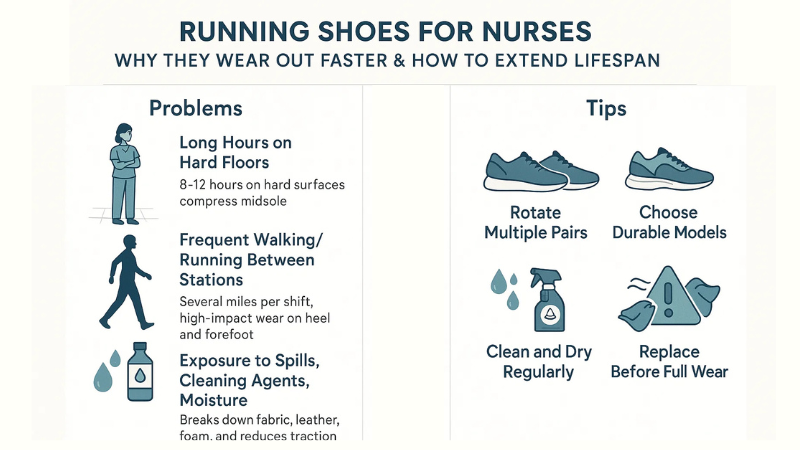
4. Do Running Shoes Wear Out Faster for Nurses?
Yes — running shoes often degrade more quickly for nurses and healthcare workers due to the unique demands of hospital and clinical environments. Unlike casual runners, nurses’ shoes endure long hours of continuous walking, standing, and exposure to challenging conditions.
1. Long Hours on Hard Floors
Nurses often spend 8–12 hours per shift on hard surfaces like tile, linoleum, or concrete. This constant pressure compresses the midsole foam, reducing cushioning and shock absorption over time. Even shoes designed for running or cross-training can lose support faster under these conditions compared to traditional jogging surfaces.
2. Frequent Walking and Running Between Stations
Healthcare staff can cover several miles per shift, often walking briskly or running between patients, labs, and supply areas. Continuous movement accelerates wear on both outsoles and insoles, especially in high-impact zones like the heel and forefoot.
3. Exposure to Spills, Cleaning Agents, and Moisture
Shoes frequently come into contact with water, disinfectants, and other cleaning chemicals, which can break down fabric, leather, and foam materials. Wet shoes also reduce traction and may increase slip risks, further impacting the durability of soles.
4. Tips to Extend Shoe Life
- Rotate Multiple Pairs:
Keep 2–3 pairs of running or supportive shoes in rotation. Use different pairs for day shifts, night shifts, and weekends to allow materials to recover.
- Choose Durable Models:
Opt for shoes with reinforced midsoles, sturdy outsoles, and water-resistant uppers.
- Clean and Dry Shoes Regularly:
Wipe off spills and moisture, and let shoes air-dry completely to prevent material breakdown.
- Replace Before Full Wear:
Don’t wait for the shoes to feel completely flat — replacing them proactively maintains comfort, support, and injury prevention.
5. Factors That Affect Shoe Durability
The lifespan of running shoes isn’t determined by mileage alone. Several internal and external factors play a role in how quickly shoes wear out. Understanding these can help you maximize durability and comfort.
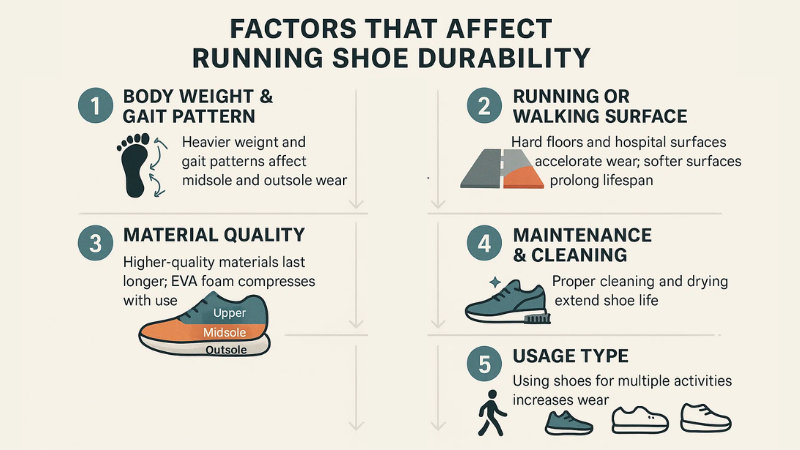
1. Body Weight & Gait Pattern
Heavier individuals naturally put more pressure on midsoles and outsoles, accelerating compression and wear. Gait patterns, such as overpronation (foot rolling inward) or supination (foot rolling outward), create uneven wear on specific areas of the shoe, like the inner or outer edges of the sole.
2. Running or Walking Surface
Hard, abrasive surfaces like concrete, asphalt, and polished hospital floors wear down soles and midsoles faster than softer surfaces like gym floors, tracks, or treadmill belts. Exposure to wet, slippery, or chemical-treated floors (common in hospitals) can degrade material and reduce grip, affecting safety as well as longevity.
3. Material Quality
The type and quality of materials used in the shoe have a major impact.
- Midsoles:
EVA foam or Phylon provide cushioning but gradually compress with repeated use.
- Outsoles:
Cheaper rubber may wear unevenly or develop holes faster, while high-quality rubber compounds last longer.
- Uppers:
Canvas or mesh may tear or stretch sooner than synthetic leather or reinforced fabrics.
4. Maintenance & Cleaning
Proper care can significantly extend shoe life.
- Air-dry shoes after exposure to moisture instead of using heat, which can weaken adhesives and foam.
- Clean dirt and debris regularly to prevent abrasions or fabric damage.
- Avoid machine washing if the manufacturer advises against it, as it can degrade cushioning and structure.
5. Usage Type
- Using running shoes for non-sport activities, such as walking long shifts, casual daily wear, or errands, adds mileage and stress beyond what the shoes are designed for.
- Combining high-impact activities and casual use accelerates wear on midsoles, insoles, and outsoles.
Understanding these factors that affect shoe durability helps you make smarter buying decisions and maintain your shoes properly. Choosing shoes for your specific body type, environment, and usage pattern ensures they last longer and continue to provide support and comfort.
Absolutely! Here’s a fully detailed, expanded, and reader-friendly version of the “How to Extend the Life of Your Running Shoes” section, combining practical advice with explanations, examples, and tips specifically for runners, nurses, and everyday walkers:
How to Extend the Life of Your Running Shoes
Running shoes are more than just footwear—they are an investment in your comfort, performance, and foot health. If you don’t take proper care, even the most perfect pairs won’t last.
But with just a little effort and proper care, you can get the most miles, months, and support from your favorite pair. Don’t be confused. In fact, it’s very easy to make them last. For that, you just have to follow some basic care steps-
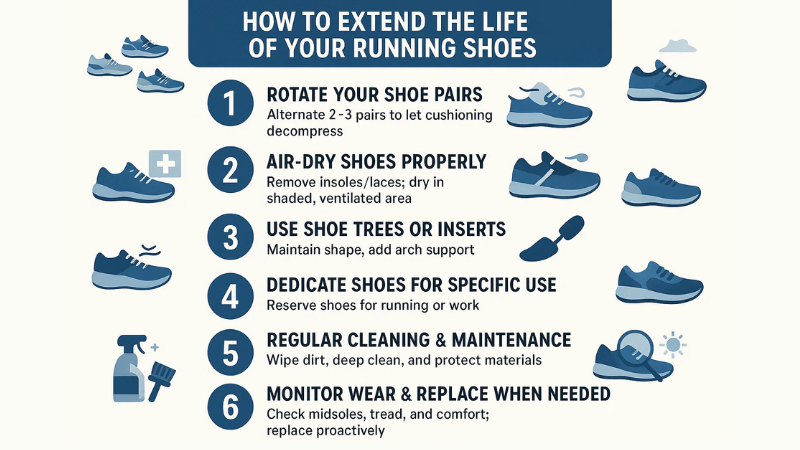
1. Rotate Your Shoe Pairs
Wearing the same pair every day accelerates midsole compression and outsole wear.
- Why Rotation Matters:
Running shoes need time to rebound after each use. Alternating between 2–3 pairs allows cushioning materials to decompress and regain shape.
- Example for Nurses:
If you spend 8–12 hours on hospital floors, consider using one pair for day shifts, another for night shifts, and a backup pair for light walking or weekend errands.
2. Air-Dry Shoes Properly
Moisture is a major factor in shoe wear and odor. Improper drying can damage shoe materials.
Best Practices:
- Remove insoles and laces to allow air circulation.
- Dry naturally in a shaded, ventilated area.
- Never place shoes directly on heaters, ovens, or in direct sunlight; heat can warp midsoles, shrink fabric, and weaken glue.
3. Use Shoe Trees or Inserts
Maintaining the shape of your shoes prevents uneven wear and preserves comfort.
- Shoe Trees:
Help maintain the toe box shape and reduce creasing in leather or synthetic uppers.
- Insoles:
Cushioned or orthotic inserts provide extra arch support, reduce stress on midsole foam, and prevent internal wear caused by repeated pressure.
4. Dedicate Shoes for Specific Use
Using shoes beyond their intended purpose accelerates wear.
- Running Shoes:
Designed for jogging, running, walking, or indoor activity—not heavy lifting, yard work, or construction.
- Healthcare Workers:
Shoes used for hospital shifts encounter hard floors, constant walking, and exposure to cleaning chemicals. Reserving one pair for hospital use keeps your running shoes performing longer.
- Everyday Use:
Avoid wearing high-performance running shoes for casual chores or errands that involve uneven surfaces, gravel, or wet conditions.
5. Regular Cleaning and Maintenance
Cleaning shoes properly extends their life and maintains hygiene.
Daily Care: Wipe off dirt and dust after each use.
- Deep Cleaning:
- Use mild soap and water to clean fabric or mesh uppers.
- Avoid machine washing unless the manufacturer’s guidelines allow it.
- Protective Measures:
- Apply water-repellent sprays for synthetic or leather uppers.
- Treat suede or nubuck with appropriate cleaners to prevent staining.
6. Monitor Wear & Replace When Needed
Even with perfect care, shoes have a finite lifespan. Paying attention to wear prevents injury and maintains performance.
- Signs to Check for:
- Flattened midsoles or compressed cushioning
- Worn-out outsole tread
- Loss of shock absorption
- Discomfort in feet, knees, or back after normal activity
- Mileage Tracking:
Keep a log of miles or steps, especially if you’re a nurse or healthcare worker walking many miles per shift. Most running shoes last 300–500 miles, but usage type and surface affect durability.
- Replacement Strategy:
Replace shoes promptly when signs of wear appear, even if they look fine externally, to prevent injuries.
7. Extra Tips for Shoe Longevity
- Store Properly:
Keep shoes in a cool, dry place. Avoid damp areas that promote material degradation.
- Avoid Excess Weight:
Carrying heavy loads or running with extra weight increases midsole compression.
- Use Shoe Bags:
Protect shoes during travel or storage to prevent scratches and dust accumulation.
- Consider Shoe Rotation Based on Season:
For example, reserve lighter, breathable shoes for summer and insulated or waterproof shoes for winter to reduce stress on any single pair.
Bottom Line: By combining rotation, proper drying, dedicated use, regular cleaning, and careful monitoring, you can significantly extend the life of your running shoes. This approach not only saves money but also ensures optimal support, comfort, and injury prevention for runners, healthcare workers.
Conclusion
Running shoes aren’t just a fashion choice—they’re a foundation for comfort, performance, and injury prevention. On average, most running shoes last 300–500 miles or 4–6 months of regular use, but certain factors like gait, body weight, and surface type can shorten their lifespan.
For nurses and healthcare workers, shoe longevity deserves extra attention. Long hours on hard floors, constant walking, and exposure to spills or cleaning agents can wear shoes faster than casual or recreational use. Monitoring visual, comfort, and performance signs, tracking mileage, and rotating 2–3 pairs can help prevent foot, knee, or back pain.
FAQs
How long should I keep my running shoes before replacing them?
Typically 300–500 miles or 4–6 months for regular use.
Is it bad to run in old shoes?
Yes, worn shoes lose cushioning and can increase injury risk, including shin splints, plantar fasciitis, and knee strain.
Do expensive running shoes last longer?
Not necessarily. Material quality and proper maintenance are more important than price.
How can I make my running shoes last longer?
Rotate pairs, air-dry properly, and avoid using them for tasks they weren’t designed for.
How do nurses know when their work shoes are worn out?
Signs include flattened soles, reduced cushioning, visible wear on the outsole, or new aches in feet, knees, or back.

Leave a Reply